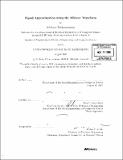| dc.contributor.advisor | Alan V. Oppenheim. | en_US |
| dc.contributor.author | Venkataraman, Archana, Ph. D. Massachusetts Institute of Technology | en_US |
| dc.contributor.other | Massachusetts Institute of Technology. Dept. of Electrical Engineering and Computer Science. | en_US |
| dc.date.accessioned | 2009-08-26T16:29:21Z | |
| dc.date.available | 2009-08-26T16:29:21Z | |
| dc.date.copyright | 2007 | en_US |
| dc.date.issued | 2007 | en_US |
| dc.identifier.uri | http://hdl.handle.net/1721.1/46466 | |
| dc.description | Thesis (M. Eng.)--Massachusetts Institute of Technology, Dept. of Electrical Engineering and Computer Science, 2007. | en_US |
| dc.description | Includes bibliographical references (p. 117-118). | en_US |
| dc.description.abstract | This thesis explores the approximation properties of a unique basis expansion. The expansion implements a nonlinear frequency warping between a continuous-time signal and its discrete-time representation according to the bilinear transform. Since there is a one-to-one mapping between the continuous-time and discrete-time frequency axes, the bilinear representation avoids any frequency aliasing distortions. We devote the first portion of this thesis to some theoretical properties of the bilinear representation, including the analysis and synthesis networks as well as bounds on the basis functions. These properties are crucial when we further analyze the bilinear approximation performance. We also consider a modified version of the bilinear representation in which the continuous-time signal is segmented using a short-duration window. This segmentation procedure affords greater time resolution and, in certain cases, improves the overall approximation quality. In the second portion of this thesis, we evaluate the approximation performance of the bilinear representation in two different applications. The first is approximating instrumental music. We compare the bilinear representation to a discrete cosine transform based approximation technique. The second application is computing the inner product of two continuous-time signals for a binary detection problem. In this case, we compare the bilinear representation with Nyquist sampling. | en_US |
| dc.description.statementofresponsibility | by Archana Venkataraman. | en_US |
| dc.format.extent | 118 p. | en_US |
| dc.language.iso | eng | en_US |
| dc.publisher | Massachusetts Institute of Technology | en_US |
| dc.rights | M.I.T. theses are protected by
copyright. They may be viewed from this source for any purpose, but
reproduction or distribution in any format is prohibited without written
permission. See provided URL for inquiries about permission. | en_US |
| dc.rights.uri | http://dspace.mit.edu/handle/1721.1/7582 | en_US |
| dc.subject | Electrical Engineering and Computer Science. | en_US |
| dc.title | Signal approximation using the bilinear transform | en_US |
| dc.type | Thesis | en_US |
| dc.description.degree | M.Eng. | en_US |
| dc.contributor.department | Massachusetts Institute of Technology. Department of Electrical Engineering and Computer Science | |
| dc.identifier.oclc | 374825613 | en_US |
